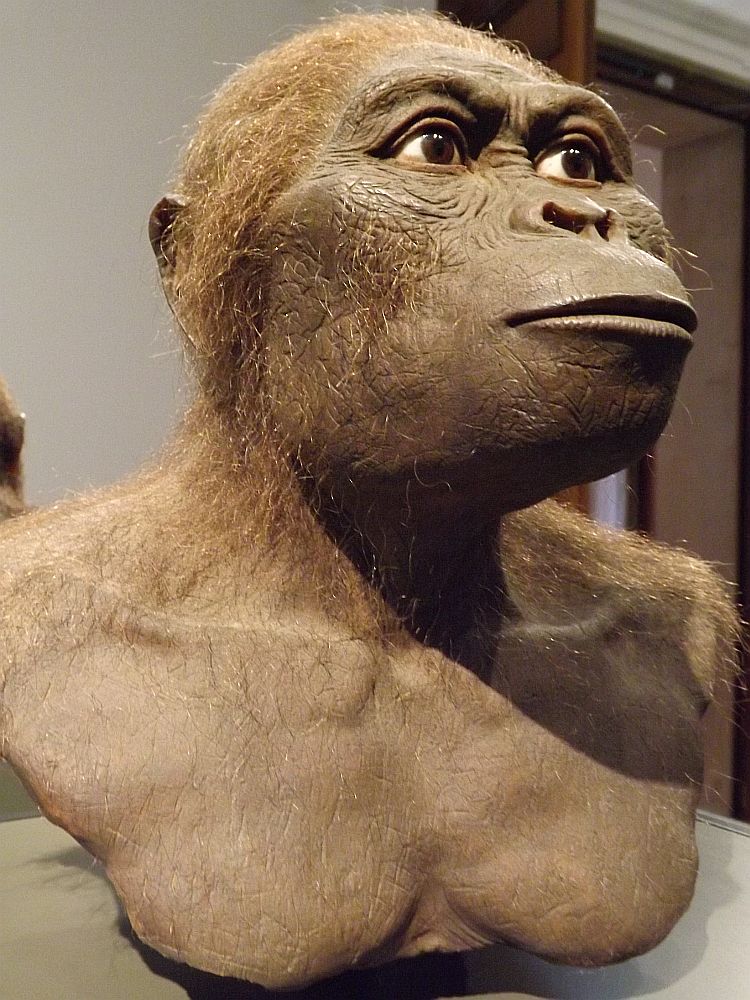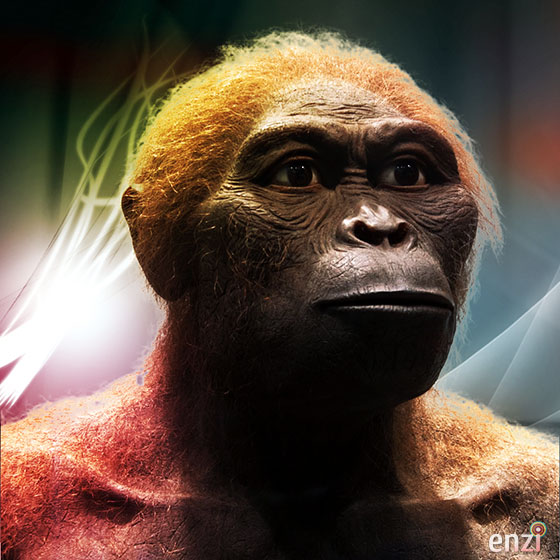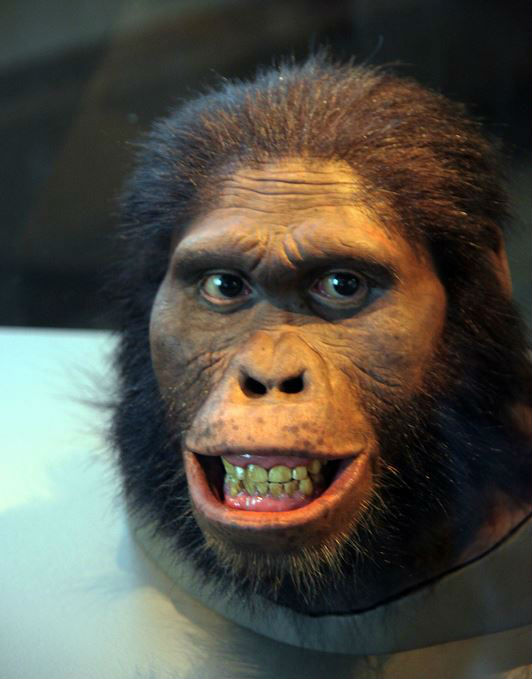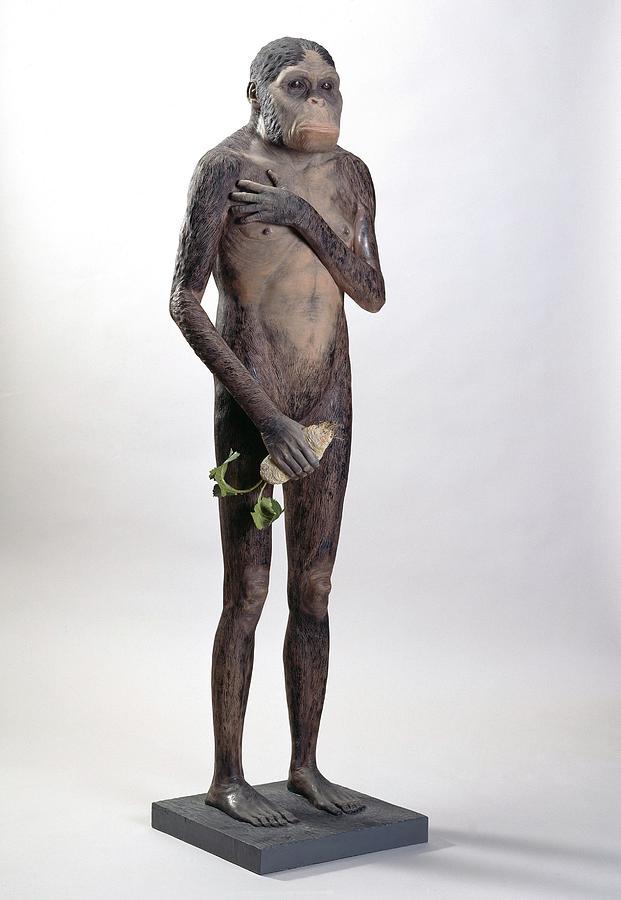Australopithecus africanus reconstruction by John Gurche Hominid, Human evolution, Ancient

Australopithecus africanus (Landesmuseum Hessen Darmstadt) Der BeutelwolfBlog
Manusia Australopithecus Africanus yang hidup sekitar 3-2 juta tahun yang lalu memiliki beberapa ciri-ciri, yaitu: Bentuk tubuhnya ramping. Volume otak 435 - 530 cc. Gigi taring kecil. Lapisan email giginya tebal dan barisan gigi rata. Bentuk tangan relatif panjang. Tulang jari agak melengkung.

Australopithecus africanus Ciencia para llevar
Australopithecus africanus was the first fossil hominin discovered in Africa. In 1924, Raymond Dart (see his biographical sketch this chapter) identified the face, mandible, and endocast as being that of a juvenile bipedal ape (see Figure 15.1). Eugène Dubois's discovery of the Javanese Homo erectus fossils in 1891 refuted the reigning.
FileAustralopithecus afarensis.JPG Wikipedia
2. Early A ustralopithecus. The origin of the genus Australopithecus remained elusive until new discoveries from the Early Pliocene in eastern Africa began to shed some light (White et al. 2006).Based on the currently available fossil evidence, Au. anamensis is the earliest species of the genus. It is documented from deposits in Kenya and Ethiopia, dated between 4.2 and 3.9 Ma (Leakey et al.

Australopithecus Africanus Stock Image C007/7646 Science Photo Library
Australopithecus africanus is an extinct species of australopithecine which lived between about 3.3 and 2.1 million years ago in the Late Pliocene to Early Pleistocene of South Africa. The species has been recovered from Taung, Sterkfontein, Makapansgat, and Gladysvale.The first specimen, the Taung child, was described by anatomist Raymond Dart in 1924, and was the first early hominin found.

Australopithecus Africanus Enzi
Everybody knows "Lucy." For nearly four decades, this famous partial skeleton of Australopithecus afarensis, dated to 3.2 million years ago, has been an ambassador for our prehistoric past, and.

Australopithecus africanus, Pliocene Hominid Stock Image C050/2023 Science Photo Library
Australopithecus africanus. Discovered: 1947 by Robert Broom and John Robinson in Sterkfontein, South Africa Age: 2.5 million years old The skull was nicknamed 'Mrs Ples' because it was originally considered to be an adult female from the genus Plesianthropus. Later, it was decided that the skull was actually an Australopithecus africanus.

Australopithecus africanus. Reconstruction based on STS 5 by John Gurche. Side view, right The
Australopithecus africanus was the first fossil hominin discovered in Africa. In 1924, Raymond Dart (see his biographical sketch this chapter) identified the face, mandible, and endocast as being that of a juvenile bipedal ape (see Figure 15.1). Eugène Dubois's discovery of the Javanese Homo erectus fossils in 1891 refuted the reigning.

Picture of Australopithecus africanus Online Biology Dictionary
Paranthropus boisei is a species of australopithecine from the Early Pleistocene of East Africa about 2.5 to 1.15 million years ago. The holotype specimen, OH 5, was discovered by palaeoanthropologist Mary Leakey in 1959 at Olduvai Gorge, Tanzania and described by her husband Louis a month later. It was originally placed into its own genus as "Zinjanthropus boisei", but is now relegated to.

Australopithecus africanus reconstruction by John Gurche Hominid, Human evolution, Ancient
The naming of Australopithecus africanus in 1925, based on the Taung Child, heralded a new era in human evolutionary studies and turned the attention of the then Eurasian-centric palaeoanthropologists to Africa, albeit with reluctance. Almost one hundred years later, Africa is recognized as the cradle of humanity, where the entire evolutionary.

Australopithecus africanus reconstruction by Maurice Wilson Prehistoric man, Paleo art
Australopithecus - Human Ancestor, African Species, Fossils: In 1925 South African anthropologist Raymond Dart coined the genus name Australopithecus to identify a child's skull recovered from mining operations at Taung in South Africa. He called it Australopithecus africanus, meaning "southern ape of Africa." From then until 1960 almost all that was known about australopiths came from.

Female Australopithecus Africanus Photograph by Natural History Museum, London/science Photo
Ronald Clarke believes that there were two species of australopith at Sterkfontein. He has assigned the species name Australopithecus prometheus to the Little Foot material, as well as two individuals that others assign to Au. africanus, one from Sterkfontein and the other from Makapansgat. While the phylogeny is unknown, Little Foot precedes.

Female Australopithecus Africanus Photograph by Natural History Museum, London/science Photo
We constructed FEMs of A. africanus and Macaca fascicularis.A. africanus is a "gracile" australopith exhibiting features of the facial skeleton hypothesized to resist elevated bite forces acting on the premolars (anterior pillars, zygomatic root positioned slightly anteriorly). The A. africanus model is a composite based on two specimens, Sts 5 and Sts 52, and is the first FEM and among.

Evolution Australopithecus africanus [GEOLINO]
Australopithecus africanus is the most primitive of this trio. The lineage dates to 3.3 million years ago and combines human features with ape-like attributes including long, tree climbing-arms.

Australopithecus africanus The Smithsonian Institution's Human Origins Program
Australopithecus (/ ˌ ɒ s t r ə l ə ˈ p ɪ θ ɪ k ə s /, OS-trə-lə-PITH-i-kəs; from Latin australis 'southern', and Ancient Greek πίθηκος (pithekos) 'ape') is a genus of early hominins that existed in Africa during the Pliocene and Early Pleistocene.The genera Homo (which includes modern humans), Paranthropus, and Kenyanthropus evolved from some Australopithecus species.

Australopithecus africanus
The australopiths are a group of early hominins (humans and their close extinct relatives) that lived in Africa between approximately 4.1 and 1.4 million years ago. Formerly known as the australopithecines, they are not a "natural" group, in that they do not represent all of the descendants of a single common ancestor (i.e., they are not a "clade"). Rather, they are grouped together.

Australopithecus africanus Taung Child reconstruction
At ~2.04 million to 1.95 million years old, DNH 152 represents the earliest definitive occurrence of Paranthropus robustus, and DNH 134 represents the earliest occurrence of a cranium with clear affinities to Homo erectus. These crania also show that Homo, Paranthropus, and Australopithecus were contemporaneous at ~2 million years ago.